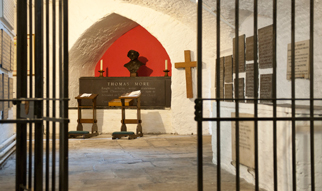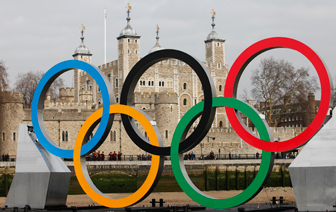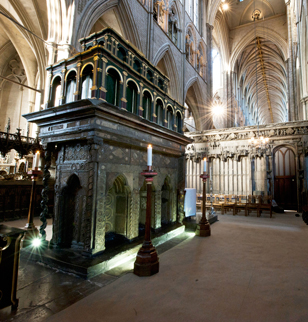
LONDON (CNS) – Visitors to the 2012 Olympic Games might be surprised to discover the extent to which London has been marked by the Catholic faith over the centuries.
Riding the trains of the London Underground they notice stations with names such as Temple, Blackfriars, Charing Cross and Covent Garden. Above ground, the traces of Catholicism are yet more noticeable: Whitefriars, Greyfriars, Ave Maria Lane and Paternoster Square all denote a rich Catholic heritage that precedes the Reformation.
Catholics never left London, and during the 16th and 17th centuries they soaked the city with their blood, with 105 beatified and canonized martyrs dying on the Tyburn gallows, while many others were executed in other parts of the capital.
However, the hope and new confidence that was ushered in with the “second spring” of the 19th century means that, today, stunning Catholic cathedrals and churches again adorn the city landscape. Here are a number of sites well worth a visit, not listed in order of importance or prominence:
1. Tyburn Convent
www.tyburnconvent.org.uk
This is the motherhouse of the Adorers of the Sacred Heart of Jesus of Montmartre, an order of cloistered Benedictine nuns, and it stands just yards from the site of the infamous “Tyburn Tree” on which more than 100 Catholics died for their faith during the Reformation. It houses the Martyrs’ Crypt, which contains bones, hair, scraps of bloodied shirts, fragments of rope and other such relics salvaged secretly by Catholics and preserved for generations. The convent is increasingly popular with visitors from the U.S., and Boston Cardinal Sean P. O’Malley often asks to celebrate Mass there when is passing through London. The nuns will show visitors around the grounds.
2. The Church of the Immaculate Conception, Farm Street
www.farmstreet.org.uk
Because of its proximity to the U.S. Embassy, the mother church of the English Jesuit province is sometimes considered the “American church.” It is worth a visit because it is the finest Catholic example of the Victorian Gothic Revival in London and one of the most beautiful churches in the city, the grandeur of its architecture exuding the joyful hope of English Catholics as they emerged from a long period of suffering.
3. Westminster Cathedral

www.westminstercathedral.org.uk
A Byzantine-style structure designed by John Francis Bentley and opened in 1903, this is the mother church of the Catholic Church in England and Wales. It is not yet completed, and mosaics are being added all the time. It is the burial place of Cardinal George Basil Hume and the other archbishops of Westminster and also of St. John Southworth, a 17th-century martyr. Take the elevator up the bell tower (the bell is named Edward after St. Edward the Confessor, patron of the archdiocese) for a spectacular view across to Buckingham Palace.
4. Westminster Abbey
www.westminster-abbey.org
This former Benedictine monastery founded by St. Edward the Confessor is the place where English monarchs are crowned, sometimes married and often buried. St. Edward’s tomb survived the frenzied destruction of shrines during the Reformation, partly because it was a royal tomb. Nearly 1,000 years after his death, he is still there. His Oct. 13 feast day is the only time when the abbey is open free of charge. Pope Benedict addressed Anglican leaders in the abbey during his 2010 visit.
5. Westminster Hall
www.parliament.uk/about/living-heritage/building/palace/westminsterhall
This is where St. Thomas More, St. Edmund Campion and many other Catholic martyrs were tried and sentenced to death, commemorated by a plaque in the center of the hall. It was the venue in which Pope Benedict XVI addressed British members of Parliament during his 2010 visit. A worthy place of pilgrimage but book in advance.
6. St. George’s Cathedral, Southwark
www.southwark-rc-cathedral.org.uk
Cardinal Nicholas Wiseman was installed as the first archbishop of Westminster here when the hierarchy of the Catholic Church of England and Wales was restored in 1850, making it the first Catholic cathedral in England since the Reformation. Ironically, this Gothic cathedral, now the seat of the archbishop of Southwark, was built on St. George’s Fields, where Lord George Gordon in 1780 incited three days of rioting – the Gordon Riots – against plans to emancipate Catholics.

7. Temple Church
www.templechurch.com
This historic gem is tucked away in the back lanes and courtyards off Fleet Street. A church of the Knights Templar, it was consecrated in 1185 by the patriarch of Jerusalem. It reflects a fashion in the Crusades era for circular naves in imitation of the Church of Holy Sepulcher in Jerusalem. It features in Dan Brown’s “The Da Vinci Code.”
8. St. Etheldreda’s Church, Holborn
www.stetheldreda.com
This is the oldest Catholic church in London, pre-dating the Reformation. Built in 1290, it was formerly the chapel of the London palace of the bishop of Ely and was lost to the Catholic Church at the Reformation before being bought by the Rosminians in 1874. It is beautifully preserved and oozes history. Its stained-glass windows are among the most beautiful in the city, and it has a collection of life-size statues of the many Catholic martyrs who once lived in the vicinity. It is within easy reach of the Ship Tavern, a pub where 18th-century Catholics secretly gathered to hear homilies by Bishop Richard Challoner.
9. St. Bartholomew the Great, West Smithfield
www.greatstbarts.com
This former Augustinian priory, built in the 12th century, survived the Great Fire of London and the World War II London Blitz; it is now an Anglican church. Its age and the solemnity of its Norman architecture make it one of the most atmospheric churches in London, and it is often sought as a location for filmmakers — “Four Weddings and a Funeral” was shot there, for example. It stands close to where William Wallace (“Braveheart”) was executed and where some Protestant – and Catholic – martyrs were burned for their faith. English artist William Hogarth was baptized there, and Benjamin Franklin, one of the founding fathers of the United States, worked there for a time as a printer.
10. The Tower of London
www.hrp.org.uk/TowerOfLondon

There is so much Catholic history associated with this one site that it is advisable to turn up early and spend the whole day there. Graffiti by such martyrs as Sts. Philip Howard and Henry Walpole is etched into the walls of the Beauchamp and Salt towers respectively and is so well-preserved that it looks recent. Sts. Thomas More and John Fisher were imprisoned there in 1535 before their executions on nearby Tower Hill. Their headless bodies, along with those of two Catholic martyrs, Blesseds William Howard (Viscount Stafford) and Countess Pole, lie in the crypt of the Chapel Royal of St. Peter ad Vincula. Other martyrs, such as St. Edmund Campion, were racked in the Tower, and St. Nicholas Owen was tortured to death there.
Other sites of interest might include a walk along Cheapside, the ancient thoroughfare off which Sts. Thomas More (Milk Street) and Thomas Becket (Ironmonger Lane) were born. Blessed John Henry Newman was born on nearby Old Broad Street.
At London Charterhouse there are still the remains of the Carthusian priory where St. John Houghton celebrated a Mass of the Holy Spirit before refusing to take the oath attached to the Act of Succession, resulting in him becoming the first martyr of the Reformation, May 4, 1535.
In London’s West End is the church of Our Lady of the Assumption and St. Gregory, Warwick Street. This was formerly the chapel of the Bavarian and Portuguese embassies and was, for a period, one of the few places in London where Catholics were free to attend Mass. It was destroyed in the Gordon Riots and rebuilt but still offers good examples of English Baroque architecture.
In Covent Garden is Corpus Christi Church, Maiden Lane, dubbed the “actors’ church.” Watch for famous faces.
Not far away is the Anglican church of St. Giles in the Fields. Eleven Catholic martyrs are buried against its northern wall, including four Jesuits and their provincial who were executed June 20, 1679, amid the hysteria of the fabricated “Popish Plot” of Titus Oates.
Heading farther west, don’t miss the London Oratory, the Renaissance-style church near Harrods and home to the Oratorians. It is popular with well-heeled and fashionable London Catholics.
London’s museums also include items of Catholic interest. The Museum of London, for instance, contains the plinth of the Monument to the Fire of London that falsely blames the disaster on Catholics, and the Clink Prison Museum on the south bank of the Thames River recreates the conditions under which Catholics were incarcerated during the Elizabethan persecution.

